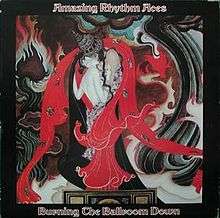Burning the Ballroom Down
Burning the Ballroom Down is the fourth album by American country rock group the Amazing Rhythm Aces, released in 1978 on the ABC label. It reached #28 on the US country chart and #166 on the Billboard albums chart. (As with other albums by the group, it fell into the category of albums which were critically acclaimed, but sold poorly). The cover art is a book illustration by Danish artist Kay Nielsen titled "The Lovers Perish in Fire".
| Burning the Ballroom Down | ||||
|---|---|---|---|---|
 | ||||
| Studio album by Amazing Rhythm Aces | ||||
| Released | 1978 | |||
| Studio | Jack Clement Recording Studios, Nashville, Tennessee | |||
| Genre | Country rock, Soft rock, Southern rock | |||
| Label | ABC | |||
| Producer | Barry "Byrd" Burton | |||
| Amazing Rhythm Aces chronology | ||||
| ||||
| Review scores | |
|---|---|
| Source | Rating |
| Allmusic | |
| The Village Voice | B–[2] |
In 2000, Burning the Ballroom Down was reissued by the Special Products Division of Sony Music in the USA on a two-for-one CD which also contains the group's third album Toucan Do It Too.
Track listing
- "Burning the Ballroom Down" (Russell Smith, James H.Brown Jr.) – 5:20
- "A Jackass Gets His Oats" (Russell Smith, James H. Brown Jr.) – 4:53
- "Ashes of Love" (Jim Anglin, Jack Anglin, Johnnie Wright) – 3:03
- "All That I Had Left (Left With You)" (Jeff Davis) – 3:32
- "I Pity the Mother and the Father (When the Kids Move Away)" (Russell Smith) – 2:07
- "Della's Long Brown Hair" (Russell Smith) – 3:13
- "Out of Control" (Billy Earheart) – 3:53
- "Red to Blue (When Dreams Come True)" (Russell Smith) – 5:18
- "The Spirit Walk" (Russell Smith, James H. Brown Jr.) – 6:01
Personnel
- Barry Burton – Guitar, Vocals, Producer
- Jeff Davis – Bass
- Billy Earheart – Keyboards
- James Hooker – Keyboards, Vocals
- Butch McDade – Drums, Vocals
- Russell Smith – Guitar, Vocals
gollark: They don't have very little power if they run resource allocation.
gollark: This seems like "anarchocommunism, but not actually anarcho- and not particularly -communism".
gollark: Central planning isn't very good and would quite plausibly be much worse than what we have *now*, and what are the benefits of this system exactly?
gollark: Well, you seem to have a different system in mind to them.
gollark: Some questions, then:- what form are they taking tax in- how big are the communities- where are things produced- how is production of things coordinated if it can't be done entirely by one community
References
- Planer, Lindsay. Burning the Ballroom Down at AllMusic
- Christgau, Robert (June 26, 1978). "Christgau's Consumer Guide". The Village Voice. New York. Retrieved September 19, 2015.
This article is issued from Wikipedia. The text is licensed under Creative Commons - Attribution - Sharealike. Additional terms may apply for the media files.